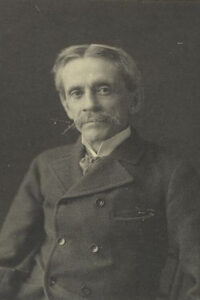
Buccaneers and Pirates of Our Coasts
When I was a boy I strongly desired to be a pirate, and the reason for this was the absolute independence of that sort of life. Restrictions of all sorts had become onerous to me, and in my reading of the adventures of the bold sea rovers of the main, I had unconsciously selected those portions of a pirate’s life that were attractive to me and had disregarded all the rest.
I had a great desire to become what might be called a marine Robin Hood. I would take from the rich and give to the poor; I would run my long, low, black craft by the side of the merchantman, and when I had loaded my vessel with the rich stuff and golden ingots that composed her cargo, I would sail away to some poor village, and make its inhabitants prosperous and happy for the rest of their lives by a judicious distribution of my booty.
I would always be as free as a seabird. My men would be devoted to me, and my word would be their law. I would decide for myself whether this or that proceeding would be proper, generous, and worthy of my unlimited power; when tired of sailing, I would retire to my island,—the position of which, in a beautiful semi-tropic ocean, would be known only to myself and to my crew,—and there I would pass happy days in the company of my books, my works of art, and all the various treasures I had taken from the mercenary vessels which I had overhauled.
Such was my notion of a pirate’s life. I would kill nobody; the very sight of my black flag would be sufficient to put an end to all thought of resistance on the part of my victims, who would no more think of fighting me than a fat bishop would have thought of lifting his hand against Robin Hood and his merry men; and I truly believe that I expected my conscience to have a great deal more to do in the way of approval of my actions, than it had found necessary in the course of my ordinary school-boy life.
I mention these early impressions because I have a notion that a great many people—and not only young people—have an idea of piracy not altogether different from that of my boyhood. They know that pirates are wicked men, that they are sea robbers or maritime murderers, but their bold and adventurous method of life, their bravery, daring, and the exciting character of their expeditions, give them something of the same charm and interest that belong to the robber knights of the middle ages. The one mounts his mailed steed and clanks his long sword against his iron stirrup, riding forth into the world with a feeling that he can do anything that pleases him if he finds himself strong enough. The other springs into his rakish craft spreads his sails to the wind, and dashes over the sparkling main with a feeling that he can do anything he pleases, provided he is strong enough.
The first pirates who made themselves known in American waters were the famous buccaneers; these began their career in a very commonplace and unobjectionable manner, and the name by which they were known had originally no piratical significance. It was derived from the French word boucanier, signifying “a drier of beef.”
Read or download Book
Frank R. Stockton
Frank Richard Stockton (April 5, 1834 – April 20, 1902) was an American writer and humorist, best known today for a series of innovative children’s fairy tales that were widely popular during the last decades of the 19th century.
Life
Born in Philadelphia in 1834, Stockton was the son of a prominent Methodist minister who discouraged him from a writing career. After marrying Mary Ann Edwards Tuttle, he and his wife moved to Burlington, New Jersey, where he produced some of his first literary work. The couple then moved to Nutley, New Jersey.
For years he supported himself as a wood engraver until his father died in 1860. In 1867, he moved back to Philadelphia to write for a newspaper founded by his brother. His first fairy tale, “Ting-a-ling,” was published that year in The Riverside Magazine; his first book collection appeared in 1870. He was also an editor for Hearth and Home magazine in the early 1870s. Around 1899, he moved to Charles Town, West Virginia.
He died in Washington, DC, on April 20, 1902, of a cerebral hemorrhage and is buried at The Woodlands in Philadelphia.
Writings
Stockton avoided the didactic moralizing common to children’s stories of the time. Instead, he humorously poked fun at greed, violence, abuse of power, and other human foibles, describing his fantastic characters’ adventures in a charming, matter-of-fact way in stories like “The Griffin and the Minor Canon” (1885) and “The Bee-Man of Orn” (1887).
These last two stories were republished in 1963 and 1964, respectively, in editions illustrated by Maurice Sendak. “The Griffin and the Minor Canon” won a Lewis Carroll Shelf Award in 1963.
His most famous fable, “The Lady, or the Tiger?” (1882), is about a man sentenced to an unusual punishment for having a romance with a king’s beloved daughter. Taken to the public arena, he is faced with two doors, behind one of which is a hungry tiger that will devour him. Behind the other is a beautiful lady-in-waiting, whom he will have to marry if he opens that door. While the crowd waits anxiously for his decision, he sees the princess among the spectators, who points him to the door on the right. The lover starts to open the door and … the story ends abruptly there. Did the princess save her love by pointing to the door leading to the lady-in-waiting, or did she prefer to see her lover die rather than see him marry someone else? That quandary has made the story a staple in English classes in American schools, especially since Stockton was careful never to hint at what he thought the ending would be. He also wrote a sequel to the story, “The Discourager of Hesitancy”.
His 1895 adventure novel The Adventures of Captain Horn was the third-best-selling book in the United States in 1895.
“The Bee Man of Orn” and several other tales were incorporated in a book published in 1887 by Charles Scribner’s Sons entitled The Bee Man of Orn. Other stories included “The Griffin and the Minor Canon”, “Old Pipes and The Dryad”, “The Queen’s Museum”, “Christmas Before Last”, “Prince Hassak’s March”, “The Battle of the Third Cousins”, “The Banished King”, and “Philopena”.
Like his contemporary Mark Twain, Stockton often pokes gentle fun at people’s credulity and irrationality. For instance, the protagonist of his “A Story of Seven Devils” (1888) is a resourceful, illiterate, preacher. One Sunday, following a scolding from his overbearing wife, he stands at the pulpit and tells his parishioners, “The Bible declared that every woman in this world was possessed by seven devils”. The women are incensed, and after prolonged discussions, the community resolves to dismiss him from his unpaid post unless he provides Biblical authority for his claim. In his next sermon he asks the villagers, “Didn’t Jesus cast seven devils from Mary Magdalene?” After his parishioners concede that Jesus did, the preacher offers the following conclusion: “But did enny ob you ebber read, or hab read to you, that he ebber cas’ ’em out o’ enny udder woman?”
Stockton’s work of science fiction, The Great War Syndicate, describes a late 19th century British–American war. An American syndicate made up of some of America’s richest men and ablest scientists conducts the war on behalf of the United States. The Syndicate quickly wins this nearly bloodless war by repeatedly demonstrating an overwhelming technological superiority. It does so through a few inventions, especially a remarkable motor bomb which can—much like the nuclear bombs developed by an Anglo-American alliance a half a century later—level entire cities.






